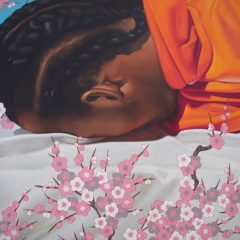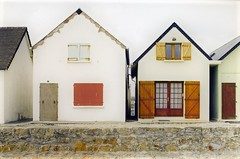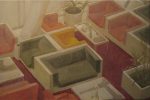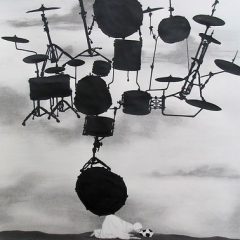Just a heads up that my review of Mark Shatabi‘s show Elevation at Jenny Jaskey/Tower Gallery is up at artnet. I’m reprinting the copy below in case you missed it. Check it out at artnet for all the pictures.
CONCRETE COLISEUM
Mark Shetabi, “Elevation,” Sept. 13-Oct. 26, 2007, at Jenny Jaskey/Tower Gallery, 969 N. Second Street, Philadelphia, Pa. 19123
Philadelphia artist Mark Shetabi’s new exhibition is as enigmatic as grand-master-level Sudoku. Titled “Elevation” and including both paintings and sculptures, Shetabi’s show focuses on a contemporary architectural icon, the parking garage, as a springboard to raise issues about surface, substrata, history and culture. It’s an exhibition whose outer simplicity and repetition masks a subtext so rich that Wikipedia would need several pages to deal with it.
Shetabi, a 2002 Pew Fellow and assistant professor at Tyler School of Art, is a long-time maker of art that takes on the big issues. As an American-born son of Iranian parents — the artist spent his childhood in Iran until 1979 when the family returned to the U.S. — he’s a member of two cultures, and often deals with the slipperiness of identity in his art. In a Shetabi work, for instance, one man’s prayer rug may be another person’s throw rug from Ikea. In this show, a simple car park — tricked out with an arena-like void in the middle to evoke the Roman Coliseum — is both a banal structure and a potential site of mayhem.
Over the last several years, Shetabi has painted pictures of military tanks and gas stations. He’s made sculptural peephole environments of ordinary scenes — a desert, an overflowing sink, the artist’s studio, a bedroom under the El. The works are always deadpan, serious and provocative.
This show is no exception, at least in terms of its poker-faced approach. What could be more deadpan than a parking garage?
Parking structures hold special interest for Shetabi, both due their architecture and as signifiers of a truth about American culture. He takes pictures of parking garages. Friends send him more pictures of garages, and his brother recently got him a video game that features a parking garage. Some of his paintings of these buildings over the years were presented in his solo show at Jeff Bailey Gallery in New York last year.
For the artist, the garage structure is a potential site of ordinary crime, as well as terrorism via car bomb. But it also epitomizes the ways that our culture has stumbled, demonstrating the devolution of idealist modernist architecture into a form of brutal utilitarianism. Fueled by consumerism, greed and aggression, Shetabi seems to suggest, we’ve maxed out our time of dominance and are one step away from Roman Empire-like meltdown.
The spiral form of the parking ramp is, of course, a pale offspring of Frank Lloyd Wright’s power spiral at the Guggenheim Museum, and an even farther cry from Vladimir Tatlin’s aggressively optimistic monument to the Third International. The spiraling parking ramp is architecture of necessity: a portal for vehicle storage, a monument of metal, glass, rubber and plastic by the ton. Ironically, our garage spiral, taken to the topmost level, to the highest ground, the highest elevation, provides sublime vistas of the surrounding terrain, for which busy people nowadays have little time.
“High ground,” by the way — a phrase used in the titles of two paintings here — has a more pointed meaning on the battlefield, where strategy commands the capture of high ground for military advantage. “Elevation,” the show’s title, is also a term used by the military, and this battlefield jargon brings Shetabi’s work into our present political context, a time of war and spiraling down, sinking, into a quagmire.
The show includes two sculptural models, both of the same parking garage. Model I is small, made of wood and painted white. It sits in a vitrine. Model II is huge, measuring 8 x 11 x 34 ft., and is constructed from 89 hollow wood doors from Home Depot, plus “every bucket of modeling paste in Philadelphia,” the artist jokes. It’s a great white whale gobbling up literal and psychic space in the narrow gallery and hulking over a viewer like an unfriendly although harmless giant.
The viewer towers over Model I and is able to decipher all the details of the structure, including its odd, Roman Coliseum-like central arena. But Model II, with its scale evoking a big play structure for children, and its forbidding prison-like walls on the sides and rear, is provocative in its complete and utter self-containment. Monumental and funereal, Model II is like a grave marker for a downward-spiraling culture.
“Elevation” is the latest exhibition assembled by Jenny Jaskey, 26, who opened her gallery last December, after a stint in the marketing and operations department at the North Carolina Museum of Art in Raleigh. Her adventurous programming and high-ceilinged, concrete-floor space quickly put her on the local art map. As a newcomer to the city, she programs without regard to Philly’s many cliques and affinity groups, often bringing together established and emerging artists in shows that are fresh and represent today’s young art scene.









